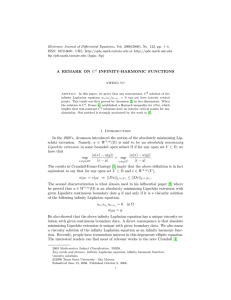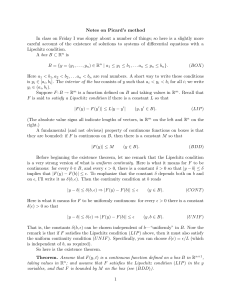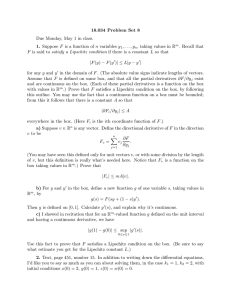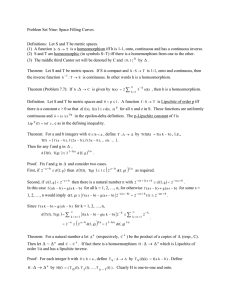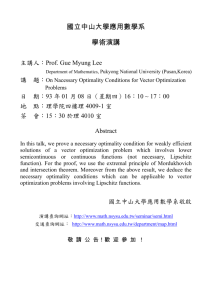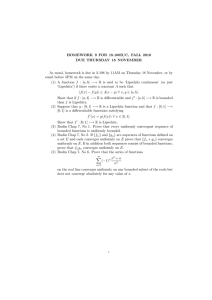Electronic Journal of Differential Equations
advertisement
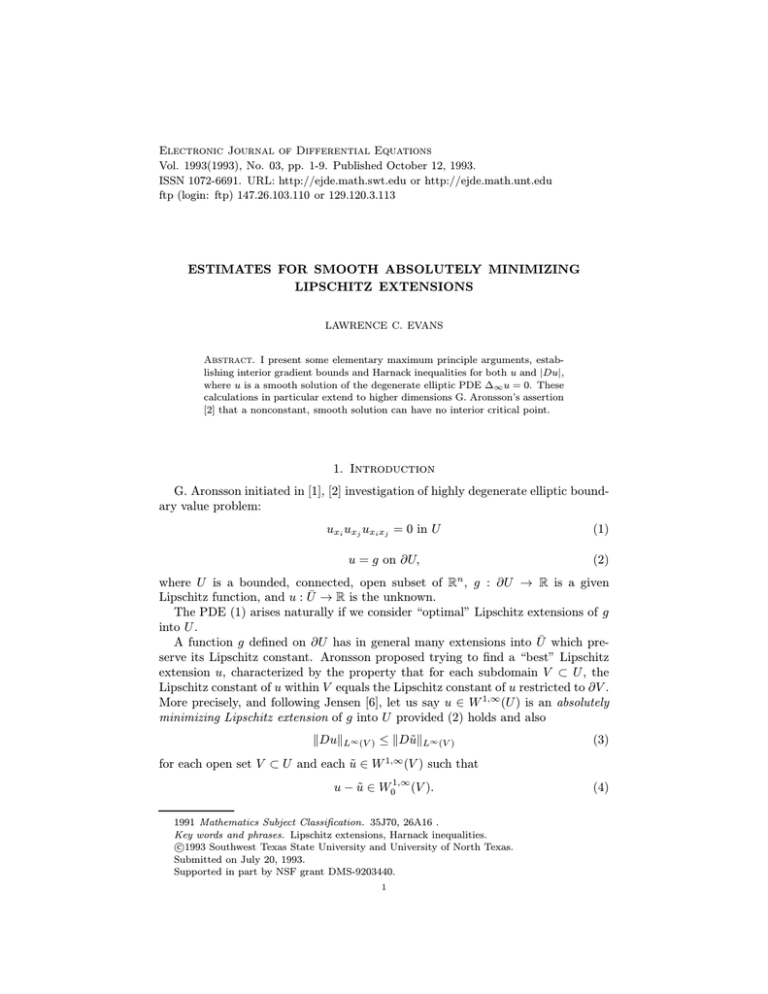
Electronic Journal of Differential Equations
Vol. 1993(1993), No. 03, pp. 1-9. Published October 12, 1993.
ISSN 1072-6691. URL: http://ejde.math.swt.edu or http://ejde.math.unt.edu
ftp (login: ftp) 147.26.103.110 or 129.120.3.113
ESTIMATES FOR SMOOTH ABSOLUTELY MINIMIZING
LIPSCHITZ EXTENSIONS
LAWRENCE C. EVANS
Abstract. I present some elementary maximum principle arguments, establishing interior gradient bounds and Harnack inequalities for both u and |Du|,
where u is a smooth solution of the degenerate elliptic PDE ∆∞ u = 0. These
calculations in particular extend to higher dimensions G. Aronsson’s assertion
[2] that a nonconstant, smooth solution can have no interior critical point.
1. Introduction
G. Aronsson initiated in [1], [2] investigation of highly degenerate elliptic boundary value problem:
uxi uxj uxi xj = 0 in U
(1)
u = g on ∂U,
(2)
where U is a bounded, connected, open subset of R , g : ∂U → R is a given
Lipschitz function, and u : Ū → R is the unknown.
The PDE (1) arises naturally if we consider “optimal” Lipschitz extensions of g
into U .
A function g defined on ∂U has in general many extensions into Ū which preserve its Lipschitz constant. Aronsson proposed trying to find a “best” Lipschitz
extension u, characterized by the property that for each subdomain V ⊂ U , the
Lipschitz constant of u within V equals the Lipschitz constant of u restricted to ∂V .
More precisely, and following Jensen [6], let us say u ∈ W 1,∞ (U ) is an absolutely
minimizing Lipschitz extension of g into U provided (2) holds and also
n
kDukL∞(V ) ≤ kDũkL∞ (V )
(3)
for each open set V ⊂ U and each ũ ∈ W 1,∞ (V ) such that
u − ũ ∈ W01,∞ (V ).
1991 Mathematics Subject Classification. 35J70, 26A16 .
Key words and phrases. Lipschitz extensions, Harnack inequalities.
c
1993
Southwest Texas State University and University of North Texas.
Submitted on July 20, 1993.
Supported in part by NSF grant DMS-9203440.
1
(4)
2
LAWRENCE C. EVANS
EJDE–1993/03
See Jensen [6] for more discussion, in particular concerning the equality
|u(x) − u(y)|
,
kDukL∞(V ) = sup
dV (x, y)
x,y∈V̄
x6=y
dV (x, y) denoting the distance from x to y within V .
As noted by Aronsson, any smooth absolutely minimizing Lipschitz extension
solves the PDE (1) within U , and Jensen provides a somewhat different proof.
The best insight for this equation is had by considering instead of (1), (2) the
corresponding boundary-value problem for the p-Laplacian:
div(|Dup |p−2 Dup ) = 0 in U,
(5)
up = g on ∂U,
(6)
when n < p < ∞. This is the Euler–Lagrange equation for the variational problem
of minimizing the energy kDũkLp (U) among all ũ ∈ W 1,p (U ) with ũ = g on ∂U . In
particular
kDup kLp (V ) ≤ kDũkLp (V )
(7)
for each open V ⊂ U and each ũ such that u − ũ ∈ W01,p (V ). Assuming up is
smooth and |Dup | 6= 0, we may rewrite (5) to read
up,xi up,xj
1
∆up +
up,xi xj = 0.
(8)
(p − 2)
|Dup |2
Suppose also we knew that as p → ∞, the function up converge in some sufficiently
strong sense to a limit u. Formally passing to limits in (7), we would expect u to
be an absolutely miminizing Lipschitz extension, and passing to limits in (8) we
expect as well u to solve the PDE (1).
R. Jensen in his important paper [6] has made these insights rigorous. In addition, he has proved that (a) any absolutely minimizing Lipschitz extension is a
weak solution of (1), and (b) any weak solution is unique. (Here “weak solution”
means a solution in the so-called viscosity sense, cf. Crandall–Ishii–Lions [4]).
In view of the construction of absolutely minimizing Lipschitz extensions as limits
of solution of the p-Laplacian, it seems reasonable to define, at least at points where
|Du| 6= 0,
the nonlinear operator
ux ux
∆∞ u = i 2j uxi xj
(9)
|Du|
as the “∞-Laplacian”.
This paper is a small contribution to the further study of smooth solutions of the
highly degenerate elliptic PDE ∆∞ u = 0, and, equivalently, of smooth absolutely
minimizing Lipschitz extensions. I provide some elementary maximum principle
arguments establishing interior sup-norm bounds on both |D(log u)| (if u > 0) and
|D(log |Du|)|. These imply in particular Harnack inequalities for u and |Du|. One
consequence is that if u is not constant, then |Du| can never vanish. This is an
extension to dimensions n ≥ 3 of a corresponding assertion of Aronsson in n = 2;
cf. also Fuglede [5].
I should point out explicitly however that in general the ∆∞ u = 0 does not
admit smooth solutions, and consequently the calculations presented here, although
I think interesting, have limited applicability in practice. For instance, Aronsson in
EJDE–1993/03
ABSOLUTELY MINIMIZING LIPSCHITZ EXTENSIONS
3
[3] has constructed a C 1 nonconstant weak solution, which does indeed possess an
interior critical point. This example shows that it is not merely a question of finding
some reasonable approximation structure to which to modify the computation from
§3.
My calculations estimating |D(log |Du|)| are somewhat reminiscent of standard
computations for minimal surfaces. This suggests comparison of the PDE ∆∞ u = 0
with the “dual” equation ∆1 u = 0, where
ux ux
Du
∆1 u = δij − i 2j uxi xj = |Du| div
.
|Du|
|Du|
Note that the operator ∆1 is degenerate, but only in the one direction normal to
each level set. By contrast, the operator ∆∞ is nondegenerate only in this direction.
Observe also
∆1 u = 0 is a “geometric” equation, since it says that the level sets of u have zero
mean curvature (at least in regions where u is smooth and |Du| > 0). This fact
suggests that the PDE ∆∞ u = 0 is somehow strongly “nongeometric”, or rather
that all its geometric information concerns not the level sets of u, but rather the
curves normal to level sets. The concluding remark in §3 makes this comment a bit
more precise.
2. Interior gradient bounds, Harnack inequality for u
In this section we present a very simple proof of interior gradient bounds and a
Harnack inequality for u.
Theorem 2.1. Let u be a C 2 solution of
∆∞ u = 0 in U.
(10)
(i) There exists a constant C such that
|Du(x0 )| ≤ CkukL∞(U) dist (x0 , ∂U )−1
(11)
for each point x0 ∈ U .
(ii) Suppose also u ≥ 0. Then for each connected open set
V ⊂⊂ U , there exists a constant C = C(V ) such that
sup u ≤ C inf u .
V
V
(12)
(iii) In particular, if U is connected and u > 0 at some point in U , then u > 0
everywhere in U . In this case, we have the estimate
|Du|
sup
≤C,
u
V
C depending only on n and dist (V, ∂U ).
Proof. 1. Write v = |Du| and suppose for the moment we know v 6= 0 in U . Then
(10) implies
uxi vxi = 0 in U.
Define
w = ζΦ(u, v),
(13)
4
LAWRENCE C. EVANS
EJDE–1993/03
where ζ ∈ Cc∞ (U ) and Φ ∈ C 2 (R2 ) are smooth nonnegative functions, to be selected
below. If w attains its maximum over Ū at a point x1 ∈ U , we have
ζΦu uxi + ζΦv vxi = −ζxi Φ (1 ≤ i ≤ n)
at x1 . Multiply by
(1 ≤ i ≤ n)
ν i = uxi /|Du| = uxi /v
and sum on i, recalling (13) to deduce
ζΦu v = −(Dζ · ν)Φ
at x1 . Consequently,
ζ|Φu |v ≤ |Dζ|Φ
(14)
at x1 .
2. Now take
Φ(u, v) = elu v
(l > 0).
Then (14) reads
lζ(x1 )v(x1 ) ≤ |Dζ(x1 )|.
(15)
Fix x0 ∈ U and take ζ ∈ Cc∞ (U ) such that ζ(x0 ) = 1, |Dζ| ≤ 2 dist (x0 , ∂U )−1 .
As w = ζΦ attains its maximum at x1 , we see that
|Du(x0 )|
= v(x0 )
2 2λkukL∞
≤
dist (x0 , ∂U )−1 .
e
λ
Set
l = kuk−1
L∞
to prove estimate (11).
3. Next, assume u ≥ 0, fix δ > 0, and take
Φ(u, v) =
v
.
u+δ
Then (14) implies
ζ
v2
v
≤ |Dζ|
2
(u + δ)
u+δ
at x1 . Consequently
w(x1 ) =
ζ(x1 )v(x1 )
≤ |Dζ(x1 )| .
u(x1 ) + δ
(16)
Given any ball B ⊂⊂ U , select ζ so that ζ ≡ 1 on B, |Dζ| ≤ C dist (B, ∂U )−1 .
As w = ζΦ attains its maximum at x1 , we conclude from (16) that
v
sup
≤ C,
u+δ
B
in constant C depending only on dist (B, ∂U ). But v = |Du|, and so
kD(log(u + δ))kL∞ (B) ≤ C.
Now take any pair of points x1 , x2 ∈ B. Let P denote the path
{tx2 + (1 − t)x1 | 0 ≤ t ≤ 1}.
(17)
EJDE–1993/03
ABSOLUTELY MINIMIZING LIPSCHITZ EXTENSIONS
Then
Z
1
log(u(x2 ) + δ) − log(u(x1 ) + δ) =
0
Z
5
d
[log(u(tx2 + (1 − t)x1 ) + δ)] dt
dt
1
D(log(u(·) + δ)) · (x2 − x1 ) dt
=
0
≤ C diam(B),
according to (17). Consequently
u(x2 ) + δ ≤ (u(x1 ) + δ)eC diam
(B)
.
Letting δ → 0, we deduce
u(x2 ) ≤ Cu(x1 )
for some constant C and each x1 , x2 ∈ B. If V ⊂⊂ U is connected, we cover V
with balls and iteratively apply the foregoing result to each B, finally to deduce
u(x2 ) ≤ Cu(x1 )
for each pair of points x1 , x2 ∈ V , the constant C depending only on V .
4. Finally, we remove the restriction v = |Du| > 0. For this define
ũ(x̃) = u(x) + εxn+1 ,
where x̃ = (x1 , . . . , xn+1 ) = (x, xn+1 ), ε > 0. Then ũ is a C 2 solution of
ũxi ũxj ũxi xj = 0 in Ũ ,
Ũ = U × R, and |Dũ| ≥ ε > 0. Apply the calculations in steps 1-3 to ũ in place of
u.
Remark. It is somewhat surprising in light of the extremely strong degeneracy
of the nonlinear operator ∆∞ that (smooth) solutions verify the interior gradient
bound (11) and the Harnack inequality (12). Such estimates are usually the hallmarks of averaging effects resulting from uniform ellipticity. It is therefore perhaps
worth noting that solutions do not in general satisfy the strong maximum principle.
For example, let u(x) = |x| and ũ(x) = xn , and take U to be the open ball of radius
one, centered at the point (0, . . . , 2). Then u, ũ are C ∞ solutions in U , u ≥ ũ in
∂U , but u = ũ in U along the line x0 = 0, x0 = (x1 , . . . , xn−1 ). This example shows
also the Harnack inequality (12) is false if we “tilt” coordinates: it is not true that
sup(u − L) ≤ C inf (u − L)
V
V
for each linear function L.
3. Harnack inequality for |Du|
Our goal next is to establish a Harnack inequality for v = |Du|, and in particular
to show a smooth, nonconstant u cannot have any critical point.
Theorem 3.1. Let u be a C 4 solution of
∆∞ u = 0 in U.
(18)
(i) Then for each smooth, connected V ⊂⊂ U there exists a constant C = C(V )
such that
sup |Du| ≤ C inf |Du|.
V
V
(19)
6
LAWRENCE C. EVANS
EJDE–1993/03
(ii) In particular, if U is connected and |Du| > 0 at some point in U , then |Du| > 0
everywhere in U . In this case
|D|Du||
≤ C,
sup
|Du|
V
C depending only on n and dist (V, ∂U ).
Proof. 1. Assume first v = |Du| > 0 everywhere in U . As above we write
ν i = uxi /|Du| = uxi /v
(1 ≤ i ≤ n),
(20)
and also write
hij = ν i ν j , gij = δij − ν i ν j
(1 ≤ i, j ≤ n).
(21)
Notice
νxi j =
1
gik uxk xj
v
vxi = ν j uxj xi
(1 ≤ i, j ≤ n),
(22)
(1 ≤ i ≤ n).
(23)
Observe further that the PDE (18) says
ν i vxi = 0.
(24)
2. We derive a PDE v satisfies. We first differentiate (24) with respect to xj and
then utilize (22) to find
1
ν i vxi xj = − gik uxk xj vxi .
v
Consequently
hij vxi xj
νj
gik uxk xj vxi
v
gik
= − vxk vxj by (23)
v
|Du|2
= −
by (24).
v
= −
Therefore
− hij vxi xj = |A|2 v,
(25)
where we have written
|Dv|2
.
(26)
v2
3. Next we compute a differential inequality satisfied by z = |A|2 . For this, first
write w = log v. Then equation (25) becomes, in light of (24),
|A|2 =
− hij wxi xj = |A|2 = z.
(27)
Now z = |Dw| , and so
2
zxi xj = 2wxk xi wxk xj + 2wxk wxk xi xj
(1 ≤ i, j ≤ n).
Hence
− hij zxi xj = −2ν i ν j wxk xi wxk xj + 2wxk (−hij wxk xi xj ).
(28)
We differentiate (27) with respect to xk and substitute above, thereby deducing
− hij zxi xj = −2ν i ν j wxk xi wxk xj + 2wxk zxk 4wxk ν j νxi k wxi xj .
(29)
EJDE–1993/03
ABSOLUTELY MINIMIZING LIPSCHITZ EXTENSIONS
7
Now (24) implies
ν j wxj = 0,
(30)
and so
ν j wxi xj = −νxj i wxj (1 ≤ i ≤ n).
We can therefore rewrite the last term in (29) as
4wxk ν j νxi k wxi xj = −4wxk wxj νxj i νxi k .
(31)
Next, we return to (22) and compute
νxj i νxi k
1
gjm uxm xi gil uxl xk
v2
1
gjm νxl m uxl xk
=
v
1
=
gjm νxl m glj uxj xk
v
= gjm νxl m νxl k ,
=
the penultimate equality holding since ν l νxl m = 0. Inserting this computation into
(31) yields
4wxk ν j νxi k wxi xj
= −4wxk wxj gjm νxl m νxl k
= −4wxk wxm νxl m νxl k by (30)
≤ 0.
Consequently, (29) implies
− hij zxi xj ≤ −2ν i ν j wxk xi wxk xj + 2wxk zxk .
(32)
But (27) tells us
z2
= (ν i ν j wxi xj )2
≤ ν i wxk xi ν j wxk xj .
Thus from (32) we discover the differential inequality
− hij zxi xj ≤ −2z 2 + 2wxk zxk .
(33)
4. We intend next to deduce from (33) an interior estimate on z. This is possible
owing to the z 2 term in (33). Indeed, let ζ ∈ Cc∞ (U ), 0 ≤ ζ ≤ 1, and write r = ζ 4 z.
Then
rxi = ζ 4 zxi + 4ζ 3 ζxi z
(1 ≤ i ≤ n),
rxi xj = ζ 4 zxi xj + 4ζ 3 (ζxj zxi + ζxi zxj ) + (4ζ 3 ζxi )xj z.
Assume r attains its positive maximum over Ū at a point x0 ∈ U . Then
Dr = 0, D2 r ≤ 0 at x0 .
Thus at the point x0 ,
0
≤ −hij rxi xj = ζ 4 (−hij zxi xj ) − 8ζ 3 hij ζxi zxj + Cζ 2 z
≤ −2ζ 4 z 2 + 2ζ 4 wxi zxi − 8ζ 3 hij ζxi zxj + Cζ 2 z ,
according to (33). Now, since Dr = 0 at x0 , we deduce from (34) that
ζzxi = −4ζxi z
(1 ≤ i ≤ n).
(34)
(35)
8
LAWRENCE C. EVANS
EJDE–1993/03
Substituting above, we compute
2ζ 4 z 2
≤ −8ζ 3 ζxi wxi z + 32ζ 2 hij ζxi ζxj z + Cζ 2 z
≤ Cζ 3 |Dw|z + Cζ 2 z
= Cζ 3 z 3/2 + Cζ 2 z.
Finally we employ Young’s inequality in the form
ab ≤ εap + C(ε)bq
(a, b > 0,
1 1
+ = 1),
p q
with p = q = 2 and p = 43 , q = 4, to deduce
2ζ 4 z 2 ≤ Cεζ 4 z 2 + C(ε).
Fix ε > 0 small enough to conclude
ζ 4 z 2 (x0 ) ≤ C.
Since r = ζ 4 z attains its maximum over Ū at x0 , we deduce that
max ζ 4 z ≤ C,
Ū
the constant C depending only on n and ζ. Given any region V ⊂⊂ U , we may
select ζ ≡ 1 on V , thereby concluding
max z ≤ C(V ).
V
(36)
As z = |Dw|2 = |D(log v)|2 , we deduce the Harnack inequality from (36) as in
the proof of Theorem 2.1.
5. If it is not true that v = |Du| > 0 everywhere in U , apply the above reasoning
to ũ(x) = u(x) + εxn+1 , and send ε → 0 to deduce |Du| = 0 everywhere in U .
Remark. The expression z = |A|2 has the following geometric interpretation (cf.
Aronsson [2]). Given a smooth solution u of ∆∞ u = 0, with |Du| > 0, set as above
ν = Du/|Du| to denote the field of normals to the level sets of u. Consider then
the ODE
ẋ(s) = ν(x(s))
(s ∈ R),
(37)
whose trajectories are curves in U normal to the level sets. Then v = |Du| is
constant along each such curve, according to (13). The curvature is
d
κ = ν(x(s)) = |Dν · ν|.
ds
But
νxi j ν j =
1
1
vx
gik uxk xj ν j = gik vxk = i = wxi .
v
v
v
Thus κ = |A|. Theorem 3.1 in particular asserts that the curvatures of each normal
curve are bounded in each region V ⊂⊂ U .
EJDE–1993/03
ABSOLUTELY MINIMIZING LIPSCHITZ EXTENSIONS
9
References
[1] G. Aronsson, Extension of functions satisfying Lipschitz conditions, Arkiv für Mate. 6 (1967),
551–561.
[2] G. Aronsson, On the partial differential equation u2x uxx + 2ux uy uxy + u2y uyy = 0, Arkiv für
Mate. 7 (1968), 395–425
[3] G. Aronsson, On certain singular solutions of the partial differential equation u2x uxx +
2ux uy uxy + u2y uyy = 0, Manuscripta Math. 47 (1984), 133–151.
[4] M. G. Crandall, H. Ishii, and P.-L. Lions, User’s guide to viscosity solutions of second-order
partial differential equations, Bull. Am. Math. Soc. 27 (1992), 1–67.
[5] B. Fuglede, A criterion of non-vanishing differential of a smooth map, Bull. London Math.
Soc. 14 (1982), 98–102.
[6] R. Jensen, Uniqueness of Lipschitz extensions minimizing the sup-norm of the gradient,
preprint, 1992.
Department of Mathematics, University of California, Berkeley,
CA 94720
E-mail: evans@math.berkeley.edu
Addenda
March 9, 1994. I should have referenced as well the interesting paper
T. Bhattacharya, E. DiBenedetto, and J. Manfredi, Limits as p → ∞ of ∆p up = f
and related external problems, Rend. Sem. Mat. Univers. Politecn. Torino,
Fascicolo Speciale (1989), Nonlinear PDE’s, pages 15-68.

